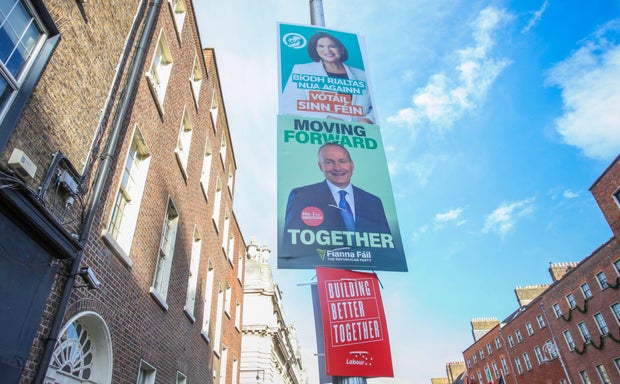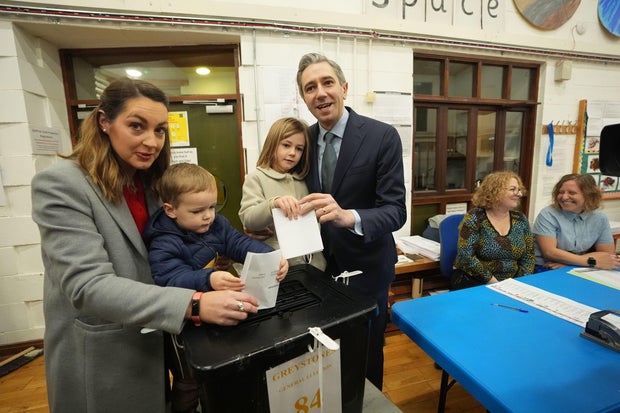Dublin — Voting began Friday in Ireland’s general election after a campaign that left the country’s three biggest political parties — Fine Gael, Fianna Fáil, and Sinn Féin — locked in what polls suggested was a dead heat. The voting will see Irish citizens choose lawmakers to fill all 174 seats in the country’s parliament, with the winning party or parties likely forming a new government and picking Ireland’s next prime minister.
Here’s what to know about the Republic of Ireland’s general election.
PAUL FAITH/AFP/Getty
Who is up for election in Ireland?
Incumbent Taoiseach (prime minister) Simon Harris, of the center-right Fine Gael party, called the election on Nov. 8, making way for a three-week general election campaign.
Either Fine Gael or the centrist Fianna Fáil party — which have led Ireland together for the last four years under the current coalition — have produced every Irish prime minister since the republic gained independence from Great Britain just over a century ago. In the aftermath of the last general election in 2020, the two longtime rivals, whose political divide can be traced back to the Irish civil war of the 1920s, came together to form the coalition.
The opposition, left-wing nationalist party Sinn Féin — the oldest political party on the Emerald Isle and previously the political arm of the Irish Republican Army — is seeking to break that cycle and become at least part of Ireland’s government for the first time ever.
But that remains a high hurdle for Sinn Féin.
The latest opinion polls suggest Sinn Féin will win around 19.5% of the vote, a share that would leave it lagging slightly behind both Fine Gael, which is polling at around 21%, and Fianna Fáil with about 21.5% of the vote. The remaining 40% of the votes are expected to be distributed among independent candidates and smaller political parties, which could have an outsized say when it comes to the horsetrading involved in building a coalition government if there is, as polls suggest, no big majority winner.
Given that the leaders of both Fianna Fáil and Fine Gael have publicly vowed not to form a coalition with the main opposition party, Sinn Féin would need to exceed expectations and overtake the two other parties in the number of seats its candidates win to put itself in the driver’s seat of the next government.
Over the course of 2024, more than half of the world’s population has had the opportunity to vote on new leadership. In a majority of those countries, voters have decisively rejected incumbent governments.
So, if Irish voters do usher the return of some form of Fine Gael-Fianna Fáil coalition — considered the most likely scenario based on recent polling — it would buck the global trend.
What’s at stake in Ireland’s election?
A Sinn Féin victory would represent a seismic shift in Ireland’s political landscape. It’s a party best known around the world as the former political wing of the IRA, the terrorist Irish republican group that wrought decades of violence on the island and in Britain during a dark period of bloodshed known as “The Troubles.”
More than 3,500 people are believed to have been killed between 1969 and 1998 as militants loyal to the British government and crown fought a bitter guerrilla war against the IRA and other nationalist Irish paramilitary groups.
In the years since the U.S.-brokered Good Friday Peace Accords brought an end to that violence in 1998, Sinn Féin leader Mary Lou McDonald has sought to distance the party from its militant past, focusing instead on left-wing economic populism and, in particular, addressing the country’s long-running housing crisis.
Dan Kitwood/Getty
In the aftermath of 2020’s general election, when Sinn Féin shocked many observers by winning a lion’s share of the popular vote — though not enough seats in parliament to gain a position in the government — it appeared as though McDonald’s strategy was working.
McDonald, who succeeded the party’s longtime stalwart Gerry Adams as Sinn Féin’s leader in 2018, appeared to be on a trajectory to become the country’s first female leader.
Sinn Féin remains the party with the most serious public commitment to achieving the aspiration of Irish nationalists — a united Ireland that includes what has, since 1921, been British-ruled Northern Ireland. McDonald has pledged to push for a referendum on Irish unification both in the Republic of Ireland and in Northern Ireland by 2030 if she’s elected.
Sinn Féin currently leads Northern Ireland’s own semi-autonomous, power-sharing government, so securing a victory in the republic could be enormously consequential in making that referendum happen, though it’s unclear how much Britain’s central government in London could try to stand in the way of such a vote.
Just as in the rest of Europe and in the U.S., immigration has dominated much of the political debate in Ireland in recent years. A wave of anti-immigrant sentiment, fuelled by the lack of affordable housing in the country, has swept over Ireland.
The country was rattled when far-right rioters, incited by a partially false claim on social media suggesting an illegal immigrant had stabbed young children, brought chaos to Dublin’s streets last year.
That sentiment has eaten into a key base of support for Sinn Féin, which is largely pro-immigration. Independent and fringe right-wing populist candidates have made gains in Irish opinion polls, as they’ve gained seats in recent local, national and European Union elections over the past year.
Early polls suggested Sinn Féin was losing momentum as the current election campaign got underway.
Simon Harris, the energetic 38-year-old leader of Fine Gael, has worked hard to keep Sinn Féin out of power. Ireland’s youngest-ever prime minister took office last April and, in the months since, he’s sought to assuage voter concerns about key issues including immigration and the housing and the cost of living crises.
A savvy social media strategy saw the Irish press dub Harris the “TikTok Taoiseach” and, under him, Fine Gael did gain ground with voters ahead of Friday’s election.
Niall Carson/PA Images/Getty
Ireland’s famously low corporation tax has led to huge investment from outside the country — not least by U.S. businesses, making it the envy of many other European nations.
Unlike their financially strapped British neighbors, the Irish government currently boasts a sizable budget surplus, which left the incumbents plenty of resources to tempt voters with promises of electricity credits, welfare payments and tax breaks in the months before Harris called the election.
But the advantage brought by Ireland’s tax policy could soon face some stiff competition. President-elect Donald Trump has pledged to match Ireland’s corporate tax rate in the U.S., a policy sweetener that could incentivize American multinationals in Dublin to pick up their business and head back home.
For the purposes of this election, however, the national budget surplus has doubtlessly benefited both Harris and Deputy Prime Minister Micheál Martin, the 64-year old veteran leader of Fianna Fáil, as they vie to become the country’s next leader.
The last-minute gift of a gaffe
Sinn Féin and Fianna Fáil were offered a late gift as their campaigns wound down.
In the final week, Fine Gael’s lead dropped by gut-punching six points, according to one Irish Times poll, after Taoiseach Harris was accosted on camera by a woman in a supermarket who protested that his government wasn’t doing enough to support disability care workers like herself.
The clip, which went viral, showed Harris tensely denying the woman’s claims before awkwardly offering a handshake and then walking away. Opponents have criticized him for being insensitive.
Whether it proves to be decisive in swinging the election toward his centrist coalition partners, or toward a landmark win for Sinn Féin, will only become clear on Saturday as the votes are counted.
www.cbsnews.com





